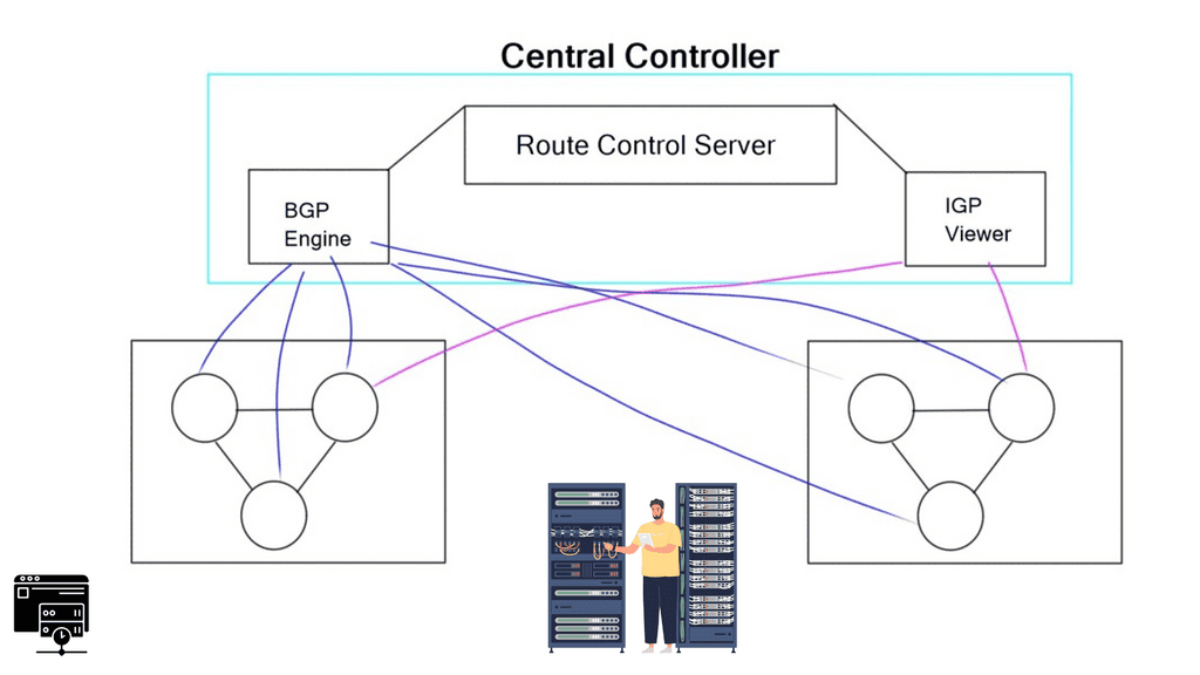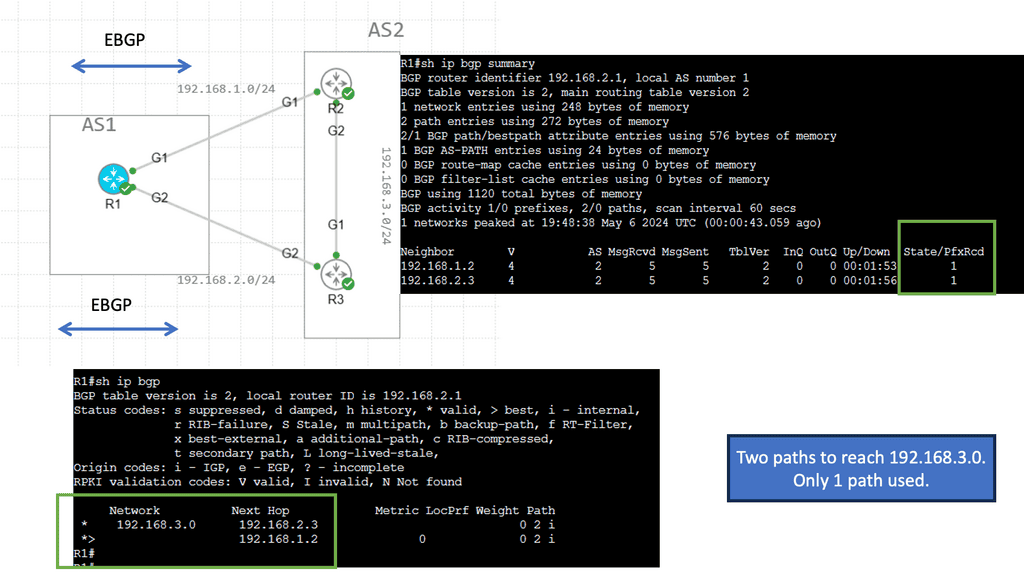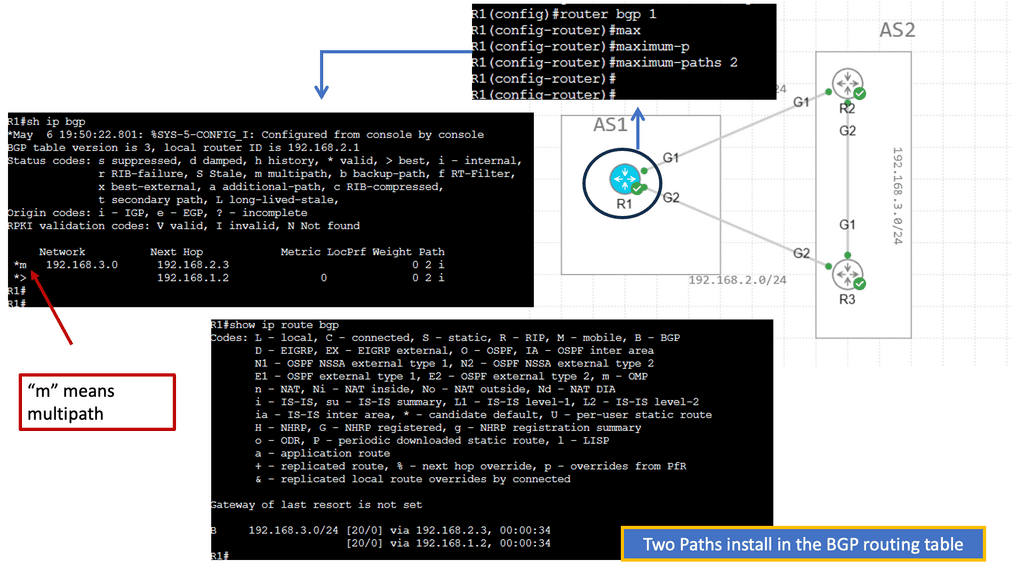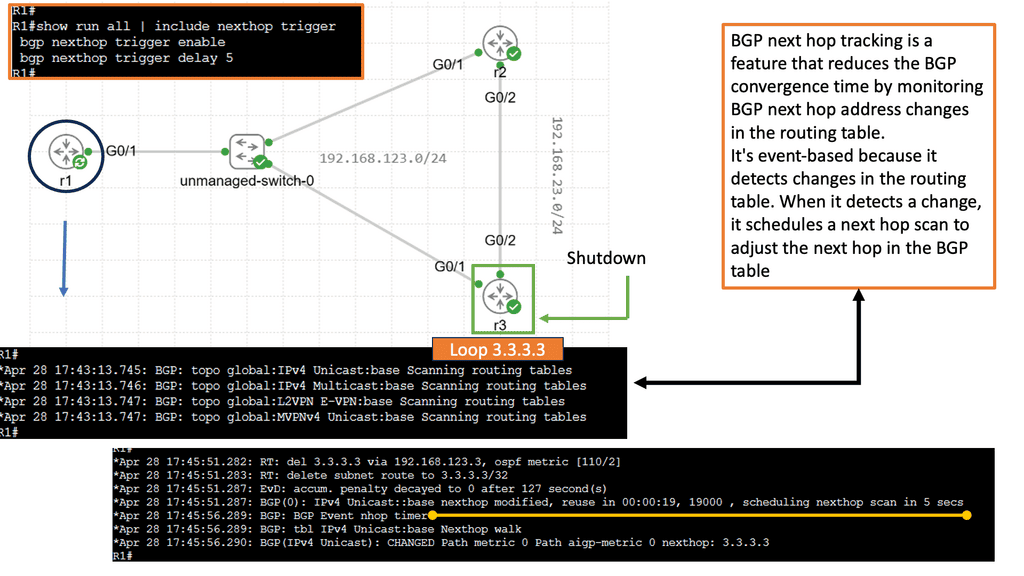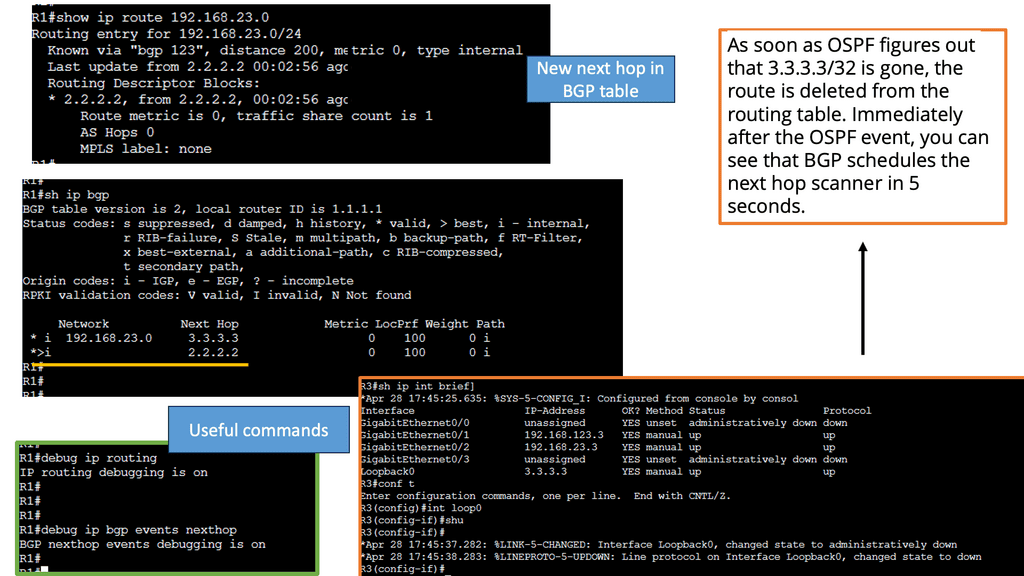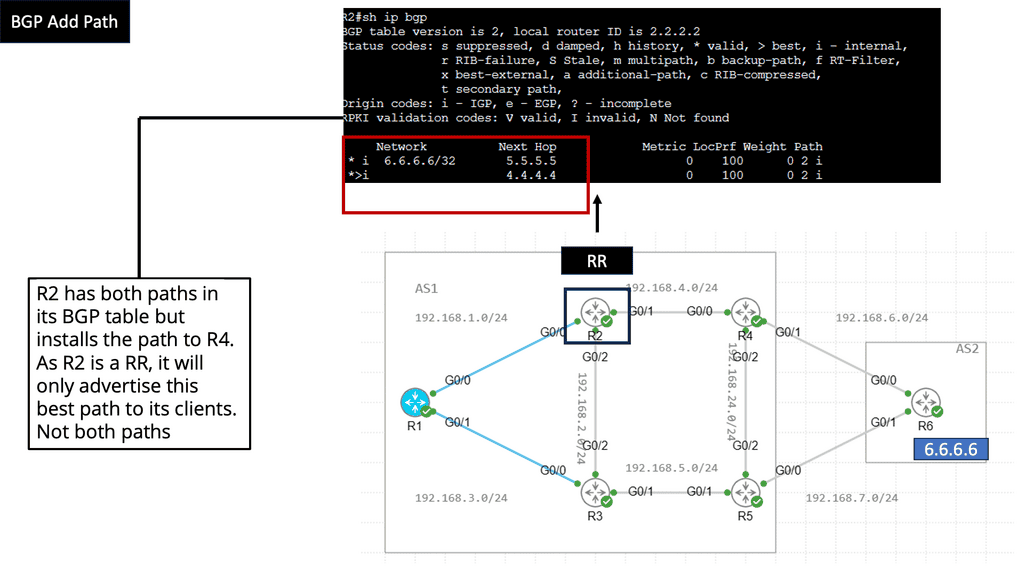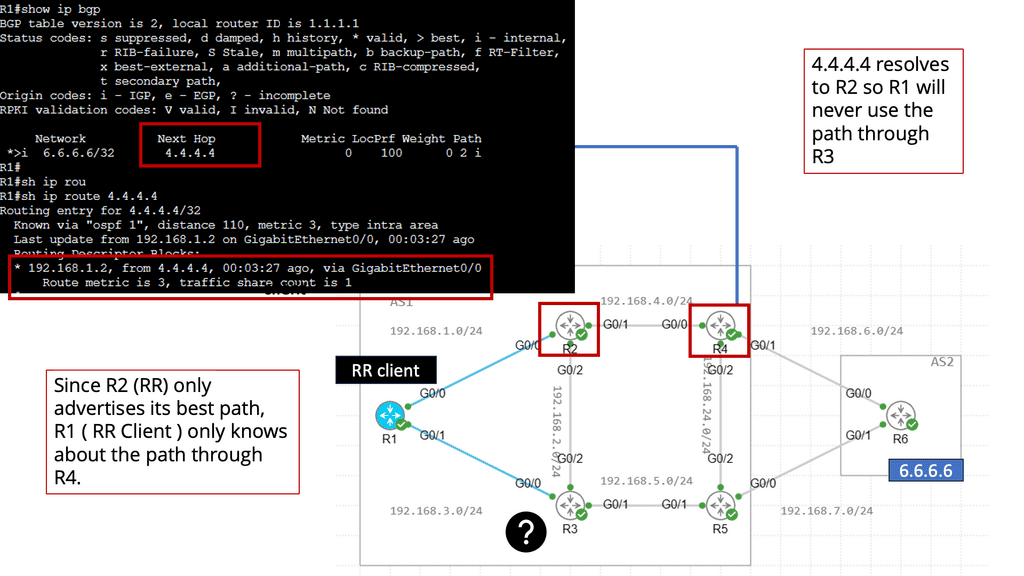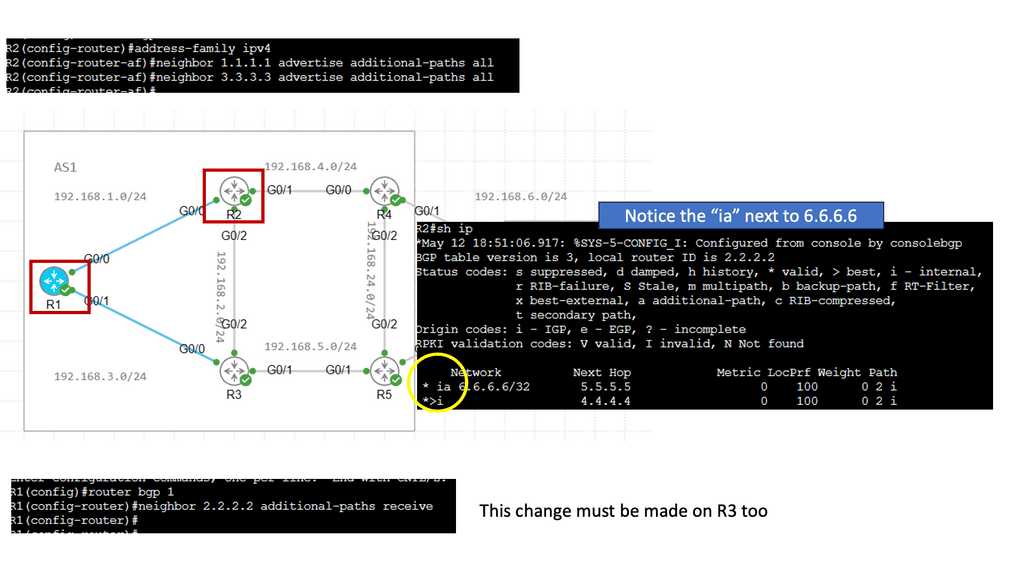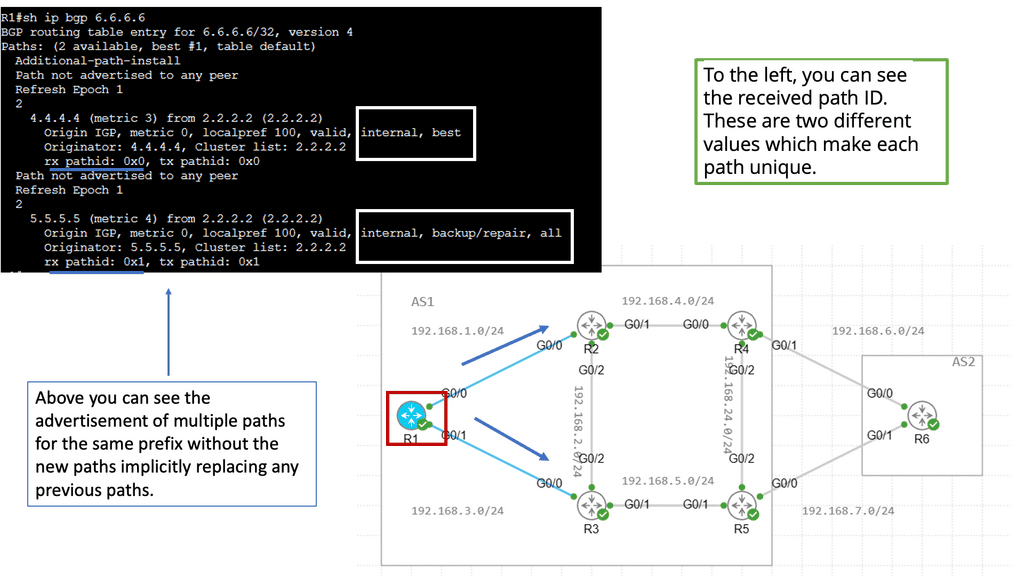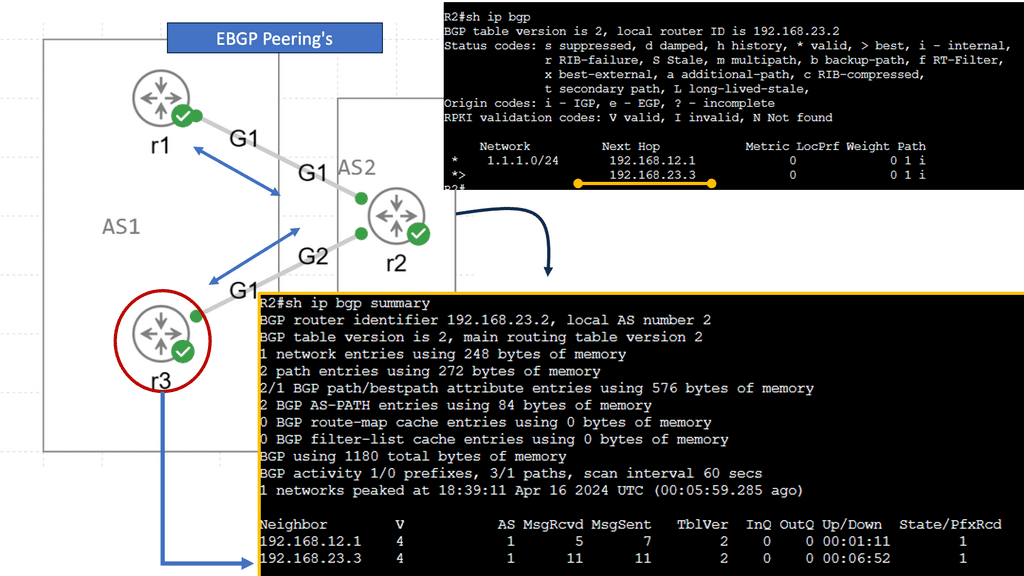Routing Control Platfrom
In today's fast-paced digital world, efficient network management is crucial for businesses and organizations. One technology that has revolutionized routing and network control is the Routing Control Platform (RCP). In this blog post, we will delve into the world of RCPs, exploring their features, benefits, and their potential impact on network infrastructure.
A Routing Control Platform is a software-based solution that offers centralized control and management of network routing. It acts as the brain behind the routing decisions, providing a unified platform for configuring, monitoring, and optimizing routing policies. By abstracting the underlying network infrastructure, RCPs bring simplicity and agility to network management.
Policy-based Routing: RCPs allow administrators to define routing policies based on various parameters such as network conditions, traffic patterns, and security requirements. This granular control enables efficient traffic engineering and enhances network performance.
Centralized Management: With RCPs, network administrators gain a centralized view and control of routing across multiple network devices. This simplifies configuration management, reduces complexity, and streamlines operations.
Dynamic Routing Adaptability: RCPs enable dynamic routing adaptability, which means they can automatically adjust routing decisions based on real-time network conditions. This ensures optimal traffic routing and improves network resiliency.
Enhanced Network Performance: RCPs optimize routing decisions, leading to improved network performance, reduced latency, and increased throughput. This translates into better user experiences and improved productivity.
Increased Flexibility: With RCPs, network administrators can easily adapt routing policies to changing business needs. This flexibility allows for rapid deployment of new services, efficient traffic engineering, and seamless integration with emerging technologies.
Simplified Network Management: RCPs provide a unified platform for managing and controlling routing across diverse network devices. This simplifies network management, reduces operational overhead, and enhances scalability.
Scalability: Ensure that the RCP can handle the scale of your network, supporting a large number of devices and routing policies without compromising performance.
Integration Capabilities: Look for RCPs that seamlessly integrate with your existing network infrastructure, including routers, switches, and SDN controllers. This ensures a smooth transition and minimizes disruption.
Security: Verify that the RCP offers robust security features, including authentication, access control, and encryption. Network security should be a top priority when implementing an RCP.
Routing Control Platforms have emerged as a game-changer in network management, offering centralized control, flexibility, and improved performance. By leveraging the power of RCPs, organizations can optimize their network infrastructure, adapt to changing demands, and stay ahead in the digital era.
Mattt Conran
Highlights: Routing Control Platfrom
As networks grow in complexity, managing them with traditional methods becomes increasingly challenging. Enter BGP-based routing control platforms—innovative solutions designed to streamline and optimize the routing process. These platforms leverage BGP to provide enhanced control, flexibility, and efficiency, making them indispensable tools for modern network management.
### How BGP Works
The primary function of BGP is to exchange routing information between different networks or autonomous systems (AS). Unlike other routing protocols that focus on speed, BGP prioritizes reliability and path selection based on a variety of attributes. BGP routers communicate using a process called ‘path vector protocol,’ where they share information about network paths and their associated policies. This ensures that data packets take the best possible route, avoiding congested or unreliable paths.
### The Role of Routing Control Platforms
Routing control platforms play a critical role in managing and optimizing BGP functions. These platforms offer network administrators the tools to monitor, manage, and manipulate BGP routes effectively. By using advanced analytics and automation, routing control platforms can enhance network performance, improve security, and reduce operational costs. They provide real-time insights and control, enabling swift responses to network issues or changes in traffic patterns.
Centralised Control
1: Routing control platforms are powerful tools that provide network administrators with centralized control and management over routing protocols. These platforms offer a comprehensive feature suite that allows fine-grained control over network traffic and routing decisions. From policy-based routing to traffic engineering, routing control platforms empower administrators to optimize network performance and enhance efficiency.
2: Effective routing control is vital for optimizing network performance, ensuring reliability, and improving overall internet connectivity. BGP-based routing control allows network administrators to influence the flow of traffic by manipulating route advertisements and selecting appropriate paths based on factors such as network policies, performance metrics, and economic considerations.
3: Internet Service Providers (ISPs) rely heavily on BGP-based routing control to manage the traffic within their networks and establish connections with other networks. By strategically configuring BGP policies, ISPs can control the routing of traffic to and from their networks, ensuring efficient utilization of their resources and maintaining high-quality services for their customers/
Routing control platforms come equipped with various features designed to streamline network operations. These include:
1. Policy-Based Routing: Administrators can define routing policies based on specific criteria such as source IP, destination IP, or application type. This allows for granular control over how network traffic is routed, enabling better traffic management and improved performance.
2. Traffic Engineering: Routing control platforms enable administrators to adjust network paths based on real-time traffic conditions dynamically. This ensures optimal utilization of available network resources and minimizes latency or bottlenecks.
3. Centralized Management: With a routing control platform, administrators can manage multiple routers and switches from a single, intuitive interface. This streamlines network management tasks and reduces the complexity of configuring individual devices.
Key Routing Control Benefits:
– Enhanced Scalability: RCPs enable efficient scaling of network infrastructure by allowing administrators to manage routing policies and protocols across a large number of routers from a single point of control. This eliminates the need for manual configuration on individual devices, reducing human errors and saving valuable time.
– Increased Flexibility: With RCPs, network administrators gain the ability to dynamically adapt routing policies based on network conditions and business requirements. RCPs provide a programmable interface that allows for automation and customization, empowering organizations to respond quickly to changing network demands.
– Improved Network Visibility: RCPs offer comprehensive monitoring and analytics capabilities, providing real-time insights into network performance, traffic patterns, and potential bottlenecks. This enhanced visibility enables proactive troubleshooting, efficient capacity planning, and optimization of network resource
Knowledge Check: BGP Route Reflection
Understanding BGP Route Reflection
– BGP route reflection is a technique used to alleviate the scalability issues in BGP networks with multiple routers. It allows for reducing full mesh connections, which can be resource-intensive and challenging to manage. By implementing route reflection, network administrators can maintain a hierarchical routing structure while reducing the complexity of BGP configurations.
– In a BGP route reflection setup, one or more route reflector (RR) routers are designated within a BGP autonomous system (AS). These RR routers serve as central points for route advertisement and dissemination. Instead of establishing full mesh connections between all routers in the AS, non-RR routers establish peering sessions only with the RR routers. This simplifies the BGP topology and reduces the number of required peerings.
– The implementation of BGP route reflection offers several advantages. Firstly, it reduces the number of BGP peerings required, resulting in reduced memory and CPU overhead on routers. Secondly, it improves network stability by preventing routing loops that can occur in a full mesh BGP setup. Additionally, route reflection enables better scalability, as new routers can be added to the network without significantly impacting the existing BGP infrastructure.
**Centralized Forwarding Solution**
The Routing Control Platform (RCP) is a centralized forwarding solution, similar to BGP SDN that enables the collection of a network topology map, running an algorithm, and selecting the preferred BGP route for each router in an Autonomous System (AS). It does this by peering both the IGP platform and iBGP to neighboring routers and communicating the preferred routes using unmodified iBGP.
It acts similarly to an enhanced route reflector and does not sit in the data path. It is a control plane device, separate from the IP forwarding plane. The RCP protocol exhibits the accuracy of a full mesh iBGP design and scalability enhancements of route reflection without sacrificing route selection correctness.
**Hot Potato Routing**
A potential issue with route reflection is that AS exit best path selection (hot potato routing) is performed by route reflectors from their IGP reference point, which in turn gets propagated to all RR clients scattered throughout the network. As a result, the best path selected may not be optimal for many RR clients as it depends on where the RR client is logically placed in the network.
You may also encounter MED-induced route oscillations. The Routing Control Platform aims to solve this problem.
Recap Technology: BGP Multipath
Understanding BGP Multipath
BGP Multipath, or Border Gateway Protocol Multipath, is a feature that allows a router to install multiple paths for the same destination prefix in its routing table. This means that instead of selecting a single best path, the router can utilize multiple paths simultaneously to distribute traffic. By doing so, BGP Multipath enhances the efficiency and resilience of network routing.
Enhanced Load Balancing: One of BGP Multipath’s primary advantages is its ability to achieve optimal load balancing across multiple paths. By distributing traffic across multiple links, the network can utilize available bandwidth more efficiently, preventing congestion and ensuring a smooth user experience.
Increased Fault Tolerance: In addition to load balancing, BGP Multipath improves network resilience by providing redundancy. If one path fails or experiences degradation, the router can automatically divert traffic to alternative paths, ensuring uninterrupted connectivity. This fault tolerance greatly enhances network reliability.
Routers need to be correctly configured to enable BGP Multipath. This involves helping the multipath feature, specifying the maximum number of parallel paths, and adjusting various parameters, such as the tie-breaking criteria. Network administrators must carefully plan and configure BGP Multipath to ensure optimal performance and avoid potential issues.
Advanced Topics:
BGP Next Hop Tracking
BGP Next Hop is the IP address BGP routers use to reach a specific destination network. It is an essential component in the BGP routing table and is vital in determining the best path for data packets. However, traditional BGP routing can face challenges when link failures occur, resulting in suboptimal routing decisions. This is where BGP Next Hop Tracking comes into play.
BGP Next Hop Tracking is a feature that allows BGP routers to actively monitor the reachability of next-hop IP addresses. By tracking the next hop, routers can quickly identify whether a particular path is still valid or if an alternative route needs to be chosen. This dynamic approach enhances network resilience and reduces downtime, enabling routers to react swiftly to link failures.
a. Improved Network Resilience: BGP Next Hop Tracking ensures routing decisions are based on real-time reachability information. This capability significantly improves network resilience by dynamically adapting to changing network conditions, such as link failures or congestion.
b. Load Balancing and Traffic Engineering: With BGP Next Hop Tracking, network administrators can implement intelligent traffic engineering techniques. Routers can distribute traffic across diverse paths by actively monitoring the reachability of multiple next-hop IP addresses, balancing the load, and optimizing network performance.
c. Seamless Failover and Fast Convergence: In the event of a link failure, BGP Next Hop Tracking enables routers to switch to an alternative path swiftly with minimal disruption. This feature ensures seamless failover and fast convergence, reducing packet loss and improving overall network performance.
Example: BGP Add Path
Understanding the BGP Add Path Feature
The BGP Add Path feature allows BGP routers to advertise multiple paths for a given destination prefix. Traditionally, BGP only advertised the best path to a destination, but with Add Path, routers can now advertise multiple paths, providing redundancy, load balancing, and more granular traffic engineering capabilities.
Redundancy and Resilience: The BGP Add Path feature advertises multiple paths and provides backup paths in case of failures, enhancing network resilience. This redundancy ensures uninterrupted connectivity and minimizes service disruptions.
Load Balancing: Add Path enables traffic load balancing across multiple paths, optimizing network utilization and improving performance. Network operators can distribute traffic based on factors such as link capacity, latency, or cost, ensuring efficient resource utilization.
Traffic Engineering: With BGP Add Path, network operators gain fine-grained control over traffic engineering. They can influence the path selection process by manipulating attributes associated with each path, such as AS path length or local preference. This flexibility empowers operators to optimize routing decisions based on their specific requirements.
Before you proceed, you may find the following blog BGP of interest:
Routing Control Platfrom
Routing Foundations
A network carries traffic where traffic flows from a start node to an end node; generally, we refer to the start node as the source node and the end node as the destination node. We must pick a path or route from the source node to the destination node. A route can be set up manually; such a route is static. Or we can have a dynamic routing protocol, such as an IGP or EGP.
With dynamic routing protocols, we have to use a routing algorithm. The role of the routing algorithm is to determine a route. Each routing algorithm will have different ways of choosing a path. Finally, a network can be expressed as a graph by mapping each node to a unique vertex in the graph, where links between network nodes are represented by edges connecting the corresponding vertices. Each edge can carry one or more weights; such weights may depict cost, delay, bandwidth, and so on. Many of these methods are now enhanced with an IGP platform and different types of routing control.
A key point: Replacing iBGP with the OpenFlow protocol
The Routing Control Platform is proposed to be enhanced by replacing iBGP with the OpenFlow protocol, which provides additional capabilities beyond next-hop forwarding. This may be useful for a BGP-free edge core and will be addressed later. The following discusses the original Routing Control Platform proposed by Princeton University and AT&T Labs-Research.
iBGP and eBGP
Routers within an AS exchange routes to external destinations using internal BGP (iBGP), and routers peer externally to their AS using external BGP (eBGP). All BGP speakers within a single AS must be fully meshed to propagate external destinations. For loop prevention, the original BGP design states reachability information learned from an iBGP router can not be forwarded to another iBGP router inside the full mesh. eBGP designs use AS-PATH for loop prevention. All routing protocols, not just BGP, require some mechanism to prevent loops.
With iBGP, the maximum number of iBGP hops an update can traverse is 1.
Example BGP Technology: Prefer eBGP over iBGP
**Section 1: Understanding eBGP and iBGP**
Before diving into the comparative advantages, it’s important to define what eBGP and iBGP are. eBGP is used for routing between different autonomous systems, making it essential for wide-area network communication, such as internet routing. Conversely, iBGP is used within the same autonomous system to ensure that all routers have a consistent view of external route information.
**Section 2: Scaling and Route Efficiency**
One of the main reasons network engineers prefer eBGP over iBGP is scalability. eBGP is designed to handle the vast scale of the internet, efficiently managing numerous routes and updates. Its ability to consolidate routing information between autonomous systems reduces the complexity seen in iBGP, which can become unwieldy as the network grows. This efficiency is particularly beneficial for internet service providers and large enterprises managing multiple connections.
**Section 3: Policy Control and Flexibility**
eBGP provides superior policy control and flexibility. It allows network administrators to apply routing policies that can manage traffic flow between autonomous systems more precisely. This level of control is crucial for optimizing network performance and ensuring that data takes the most efficient path. iBGP, while useful within an AS, lacks this external policy flexibility, making eBGP more favorable for strategic traffic routing.
**Section 4: Path Attributes and Preference**
Another consideration is the path attribute preferences in BGP. eBGP allows for the easy implementation of path attributes such as AS path, which can influence routing decisions and ensure more secure and reliable paths. This attribute is integral in avoiding routing loops and optimizing the chosen paths, offering a clear advantage over iBGP, which does not inherently prioritize these external path attributes.
Route-reflection (RR) and confederations
To combat the scalability concerns with an iBGP full mesh design, in 1996, several alternatives, such as route reflection and confederations, were proposed. Both of these enable hierarchies within the topology. However, route reflection has drawbacks, which may result in path diversity and network performance side effects. There is a trade-off between routing correctness and scalability. With iBGP full mesh designs, if one BGP router fails, it will have a limited impact. An update travels only one i-BGP hop. However, if a route reflector fails, it has an extensive network impact. All iBGP peers peering with the route reflector are affected.
An update message may traverse multiple route reflectors with a route reflection design before reaching the desired i-BGP router. This may have adverse effects, such as prolonged routing convergence. One of route reflection’s most significant adverse effects is reduced path diversity. A high path diversity can increase resilience, while low path diversity will decrease resilience. Since a route reflector only passes its best route, all clients peering with that route reflector use the same path for that given destination.
- BGP Multipath and the Add Path capability
Proper route reflector placement and design can eliminate some of these drawbacks. We now have path diversity mechanisms such as the BGP ADD Path capability and parallel peerings for better route reflection design. These were not available during the original RCP proposal.
Routing Control Platform (RCP)
The RCP consists of several components: 1) Route Control Server ( RCS), 2) BGP Engine, and 3) IGP platform viewer. It is similar to the newer BGP SDN platform proposed by Petr Lapukhov but has an additional IGP platform viewer function. Petr’s BGP SDN solution proposes a single Layer 3 protocol with BGP – a pure Layer 3 data center.
The RCP platform has two types of peerings: IGP and iBGP. It obtains IGP information by peering with IGP and learns BGP routes with iBGP. The Route Control Server component then analyzes the IGP and BGP viewer information to compute the best path and send it back via iBGP. Notice how the IGP Viewer only needs one peering into each partition in the diagram below.
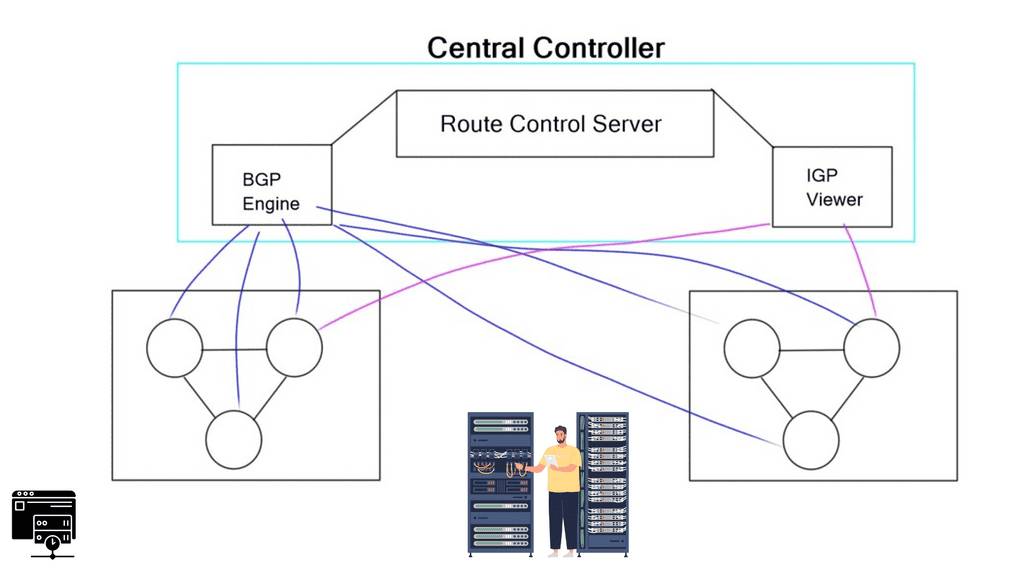
Since the link-state protocol uses reliable LSA flooding, the IGP viewer has an up-to-date topology view. To keep the IGP viewer out of the data plane, higher costs are configured on the links to the controller. As discussed, the BGP engine creates iBGP sessions for other directly reachable speakers or via the IGP.
By combining these elements, the RCS has full BGP and IGP topology information and can make routing decisions for routers in a particular partition. The RCP must have complete visibility. Otherwise, it could assign routes that create black holes, forwarding loops, or other issues preventing packets from reaching their destinations.
Centralized controller: Extract the topology
RPC uses a centralized controller to extract the topology and make routing decisions. These decisions are then pushed to the data plane nodes to forward data packets. It aims to offer the correctness of full-mesh iBGP designs and the scalability of route reflector designs. It uses iBGP sessions to peer with BGP speakers, learn topology information, and send routing decisions for destination prefixes.
As previously discussed, a route reflector design only sends its best path to clients, which limits path diversity. However, the RCP platform overcomes this route reflector limitation and sends each router a route it would have selected in an iBGP full mesh design.
Closing Points on Routing Control Platforms
Routing control platforms are the unsung heroes of network management. They are responsible for determining the best possible paths for data to travel through the internet. By analyzing various network metrics, these platforms make real-time decisions to optimize traffic flow, reduce latency, and enhance the overall user experience.
At the heart of routing control platforms lies complex algorithms and protocols. Border Gateway Protocol (BGP) is one of the key protocols that facilitate data routing between different networks. These platforms leverage BGP along with other technologies to make intelligent routing decisions. The integration of machine learning and artificial intelligence is also beginning to redefine how these platforms operate, offering predictive analytics and dynamic routing adjustments.
The evolution of routing control platforms is marked by several groundbreaking innovations. Software-Defined Networking (SDN) has emerged as a game-changer, enabling more flexible and programmable network management. Additionally, the advent of edge computing is transforming routing strategies, allowing data processing closer to the source and reducing the burden on centralized data centers.
While routing control platforms offer immense benefits, they also face significant challenges. Security remains a top concern, with platforms needing robust measures to prevent data breaches and cyber attacks. However, these challenges present opportunities for innovation, with companies investing in advanced security protocols and designing more resilient network architectures.
Summary: Routing Control Platfrom
Routing control platforms play a crucial role in managing and optimizing network infrastructures. From enhancing network performance to ensuring efficient traffic routing, these platforms have become indispensable in the digital era. In this blog post, we explored the world of routing control platforms, their functionalities, benefits, and how they empower network management.
Understanding Routing Control Platforms
Routing control platforms are sophisticated software solutions designed to control and manage network traffic routing. They provide network administrators with comprehensive visibility and control over the flow of data packets within a network. By leveraging advanced algorithms and protocols, these platforms enable efficient decision-making regarding packet routing, ensuring optimal performance and reliability.
Key Features and Functionalities
Routing control platforms offer many features and functionalities that empower network management. These include:
1. Centralized Traffic Control: Routing control platforms provide a centralized interface for monitoring and controlling network traffic. Administrators can define routing policies, prioritize traffic, and adjust routing paths based on real-time conditions.
2. Traffic Engineering: With advanced traffic engineering capabilities, these platforms enable administrators to optimize network paths and distribute traffic evenly across multiple links. This ensures efficient resource utilization and minimizes congestion.
3. Security and Policy Enforcement: Routing control platforms offer robust security mechanisms to protect networks from unauthorized access and potential threats. They enforce policies, such as access control lists and firewall rules, to safeguard sensitive data and maintain network integrity.
Benefits of Routing Control Platforms
Implementing a routing control platform brings several benefits to network management:
1. Enhanced Performance: Routing control platforms improve overall network performance by efficiently managing traffic routing and optimizing network paths, reducing latency and packet loss.
2. Increased Reliability: These platforms enable administrators to implement redundancy and failover mechanisms, ensuring uninterrupted network connectivity and minimizing downtime.
3. Flexibility and Scalability: Routing control platforms provide the flexibility to adapt to changing network requirements and scale as the network grows. They support dynamic routing protocols and can accommodate new network elements seamlessly.
Conclusion
Routing control platforms have revolutionized network management by providing administrators with powerful tools to optimize traffic routing and enhance network performance. These platforms empower organizations to build robust and efficient networks, from centralized traffic control to advanced traffic engineering capabilities. By harnessing the benefits of routing control platforms, network administrators can unlock the true potential of their infrastructures and deliver a seamless user experience.

